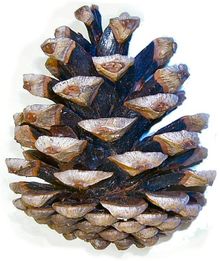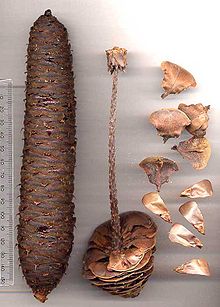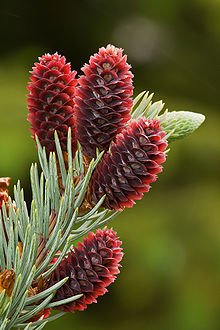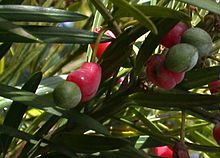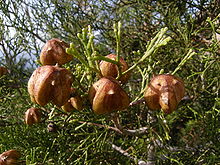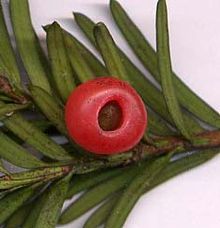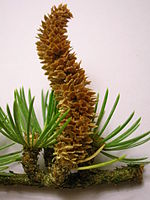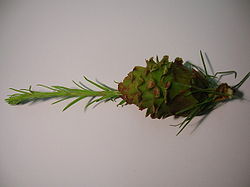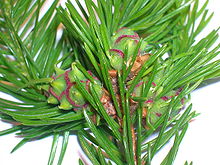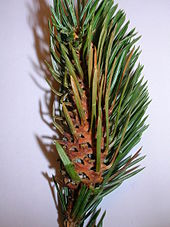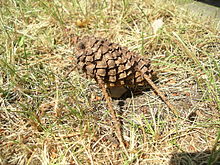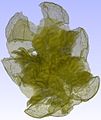- Conifer cone
-
A cone (in formal botanical usage: strobilus, plural strobili) is an organ on plants in the division Pinophyta (conifers) that contains the reproductive structures. The familiar woody cone is the female cone, which produces seeds. The male cones, which produce pollen, are usually herbaceous and much less conspicuous even at full maturity. The name "cone" derives from the fact that the shape in some species resembles a geometric cone. The individual plates of a cone are known as scales.
The male cone (microstrobilus or pollen cone) is structurally similar across all conifers, differing only in small ways (mostly in scale arrangement) from species to species. Extending out from a central axis are microsporophylls (modified leaves). Under each microsporophyll is one or several microsporangia (pollen sacs).
The female cone (megastrobilus, seed cone, or ovulate cone) contains ovules which, when fertilized by pollen, become seeds. The female cone structure varies more markedly between the different conifer families, and is often crucial for the identification of many species of conifers.
Contents
Female cones of the conifer families
Pinaceae cones
The members of the pine family (pines, spruces, firs, cedars, larches, etc.) have cones that are imbricate with scales overlapping each other like fish scales. These are the "archetypal" cones. The scales are spirally arranged in fibonacci number ratios.
The female cone has two types of scale: the bract scales, derived from a modified leaf, and the seed scales (or ovuliferous scales), one subtended by each bract scale, derived from a highly modified branchlet. On the upper-side base of each seed scale are two ovules that develop into seeds after fertilisation by pollen grains. The bract scales develop first, and are conspicuous at the time of pollination; the seed scales develop later to enclose and protect the seeds, with the bract scales often not growing further. The scales open temporarily to receive gametophytes, then close during fertilization and maturation, and then re-open again at maturity to allow the seed to escape. Maturation takes 6–8 months from pollination in most Pinaceae genera, but 12 months in cedars and 18–24 months (rarely more) in most pines. The cones open either by the seed scales flexing back when they dry out, or (in firs, cedars and golden larch) by the cones disintegrating with the seed scales falling off. The cones are conic, cylindrical or ovoid (egg-shaped), and small to very large, from 2–60 cm long and 1–20 cm broad.
After ripening, the opening of non-serotinous pine cones is associated with their moisture content—cones are open when dry and closed when wet.[1] This assures that the small, wind disseminated seeds will be dispersed during relatively dry weather, and thus, the distance traveled from the parent tree will be enhanced. A pine cone will go through many cycles of opening and closing during its life span, even after seed dispersal is complete.[2] This process occurs with older cones while attached to branches and even after the older cones have fallen to the forest floor. The condition of fallen pine cones is a crude indication of the forest floor's moisture content, which is an important indication of wildfire risk. Closed cones indicate damp conditions while open cones indicate the forest floor is dry.
Araucariaceae cones
Members of the Araucariaceae (Araucaria, Agathis, Wollemia) have the bract and seed scales fully fused, and have only one ovule on each scale. The cones are spherical or nearly so, and large to very large, 5–30 cm diameter, and mature in 18 months; at maturity, they disintegrate to release the seeds. In Agathis, the seeds are winged and separate readily from the seed scale, but in the other two genera, the seed is wingless and fused to the scale.
Podocarpaceae cones
The cones of the Podocarpaceae are similar in function, though not in development, to those of the Taxaceae (q.v. below), being berry-like with the scales highly modified, evolved to attract birds into dispersing the seeds. In most of the genera, two to ten or more scales are fused together into a usually swollen, brightly coloured, soft, edible fleshy aril. Usually only one or two scales at the apex of the cone are fertile, each bearing a single wingless seed, but in Saxegothaea several scales may be fertile. The fleshy scale complex is 0.5–3 cm long, and the seeds 4–10 mm long. In some genera (e.g. Prumnopitys), the scales are minute and not fleshy, but the seed coat develops a fleshy layer instead, the cone having the appearance of one to three small plums on a central stem. The seeds have a hard coat evolved to resist digestion in the bird's stomach, and are passed in the bird's droppings.
Cupressaceae cones
Members of the cypress family (cypresses, arborvitae, junipers, redwoods, etc.) differ in that the bract and seed scales are fully fused, with the bract visible as no more than a small lump or spine on the scale. The botanical term galbulus (plural galbuli; from the Latin for a cypress cone) is sometimes used instead of strobilus for members of this family. The female cones have one to 20 ovules on each scale. They often have peltate scales, as opposed to the imbricate cones described above, though some have imbricate scales. The cones are usually small, 0.3–6 cm long, and often spherical or nearly so, like those of Nootka Cypress, while others, such as Western Redcedar, are narrow. The scales are arranged either spirally, or in decussate whorls of two (opposite pairs) or three, rarely four. The genera with spiral scale arrangement were often treated in a separate family (Taxodiaceae) in the past. In most of the genera, the cones are woody and the seeds have two narrow wings (one along each side of the seed), but in three genera (Platycladus, Microbiota and Juniperus), the seeds are wingless, and in Juniperus, the cones are fleshy and berry-like.
Sciadopityaceae cones
The cones and seeds of Sciadopitys (the only member of the family) are similar to those of some Cupressaceae, but larger, 6–11 cm long; the scales are imbricate and spirally arranged, and have 5-9 ovules on each scale.
Taxaceae and Cephalotaxaceae cones
Members of the yew family and the closely related Cephalotaxaceae have the most highly modified cones of any conifer. There is only one scale in the female cone, with a single poisonous ovule. The scale develops into a soft, brightly coloured sweet, juicy, berry-like aril which partly encloses the deadly seed. The seed alone is poisonous. The whole 'berry' with the seed is eaten by birds, which digest the sugar-rich scale and pass the hard seed undamaged in their droppings, so dispersing the seed far from the parent plant.
Location and distribution
For most species, male and female cones occur on the same plant (tree or shrub), with female usually on the higher branches towards the top of the plant. This distribution is thought to improve chances of cross-fertilization, as pollen is unlikely to be blown vertically upward within the crown of one plant, but can drift slowly upward in the wind, blowing from low on one plant to higher on another plant. In some conifers, male cones additionally often grow clustered in large numbers together, while female cones are more often produced singly or in only small clusters.
A further characteristic arrangement of pines is that the male cones are located at the base of the branch, while the female at the tip (of the same or a different branchlet). However, in larches and cedars, both types of cones are always at the tips of short shoots, while both sexes of fir cones are always from side buds, never terminal. There's also some diversity in bearing in Cupressaceae. Some, Cupressus for instance, has little or no differentiation in the positions of male and female cones.
Pseudocones
Norway and Sitka spruce are prone to the formation of Pineapple gall pseudocones caused by the woolly aphid, Adelges abietis. These are not cones, although they closely resemble them.
Alder trees are not even conifers, however the mature seed bearing structures closely resemble cones.
Cultural uses of cones
Because of their widespread occurrence, conifer cones have been a traditional part of the arts and crafts of cultures where conifers are common. Examples of their use includes seasonal wreaths and decorations, fire starters, bird feeders, toys, etc.[3] An intriguing derivation of the impossible bottle mechanical puzzle takes advantage of the fact that pine cones open and close based on their level of dryness. In constructing the pine cone in the bottle display, a closed, damp cone of suitable size is inserted into a narrow-mouthed bottle and allowed to open upon drying.[4]
Cone cows are traditional homemade toys, made by children using material found in nature. The most common design is a spruce or pine cone with sticks or matches for legs, which can easily be attached by forcing them between the cone scales. Playing with cone cows often includes building an animal enclosure from sticks. For the most part, cone cows have been displaced by manufactured toys, at least in affluent countries, but the creation of cone cows still enjoys some popularity as an outdoor activity for children.
Cone cows are a part of children's culture in Finland where they are known as Käpylehmä (plural: Käpylehmät) and Sweden where they are known as kottkor or kottdjur (cone animals). Schools and other institutions teach children how to make cone cows as part of outdoors education on nature and history.
In Finland there is a fairground with cone cow sculptures large enough for children to ride on. In Sweden, a video game was released in which the player may build virtual cone cows.[5] Swedish artist Lasse Åberg has created artwork with cone cows, which has been included in an alphabet book[6] and featured on a Swedish postage stamp among other classic toys.[7][8]
Gallery
-
A pine cone covered in ice after an ice storm.
-
Pollen cone of a Japanese Larch
-
Pineapple gall on Sitka Spruce caused by Adelges abietis.
-
Dozens of male cones (orange and flower-like) occur in a cluster; the female cone is still immature (olive green). Lodgepole Pine.
-
Young female cones of loblolly pine receptive for pollination.
-
Loblolly pine male cones ready to cast pollen.
-
Loblolly pine branch with cones of different ages; 2-yr old cones will disperse seeds during fall and winter.
-
Cluster of Norway Spruce cones on Hokkaidō.
Visualisation of a Cupressus cone by micro computed tomography
-
Flight around the 3D object.
-
Flight through the µCT image stack, lateral view.
-
Flight through the µCT image stack, top view.
References
- ^ Dawson, Colin; Vincent, Julian F. V.; Rocca, Anne-Marie. 1997. How pine cones open. Nature 390: 668.
- ^ Ask a Scientist: Pine Cone Wet and Dry.
- ^ Pine Cone Craft Projects
- ^ Instructables: Pine Cone in the Bottle Display.
- ^ Kapsyljakt med Anki och Pytte review "You build cone cows"
- ^ Åbergs ABC "a little book about cone cows, small fears, swarming helicopters and such"
- ^ Posten.se press release "Motives include [..] life in the countryside, which shows both the cone cow, a doll in a traditional outfit, and a horse and carriage toy"
- ^ Livet på landet image of the stamp from the official postal site
External links
- Arboretum de Villardebelle Images of various conifer-cones
- Gymnosperm cone images at bioimages.vanderbilt.edu
Categories:- Conifers
- Plant morphology
-
Wikimedia Foundation. 2010.

